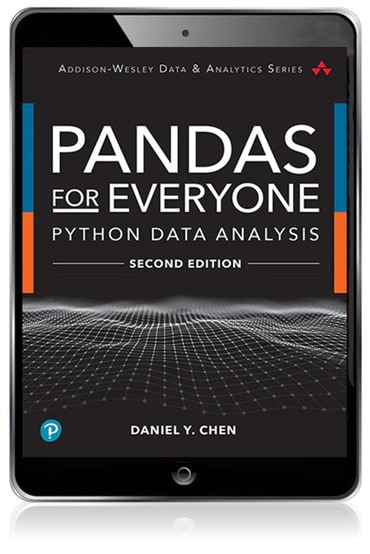
Pandas for Everyone: Python Data Analysis, 2nd edition
Published by Addison-Wesley Professional (November 24, 2022) © 2023
- Daniel Y. Chen
Title overview
Manage and automate data analysis with pandas in python
Today, analysts must manage data characterized by extraordinary variety, velocity, and volume. Using the open source Pandas library, you can use Python to rapidly automate and perform virtually any data analysis task, no matter how large or complex. Pandas can help you ensure the veracity of your data, visualise it for effective decision-making, and reliably reproduce analyses across multiple data sets.
Pandas for Everyone, 2nd Edition, brings together practical knowledge and insight for solving real problems with Pandas, even if you're new to Python data analysis. Daniel Y. Chen introduces key concepts through simple but practical examples, incrementally building on them to solve more difficult, real-world data science problems such as using regularisation to prevent data overfitting, or when to use unsupervised machine learning methods to find the underlying structure in a data set.
New features to the second edition include:
- Extended coverage of plotting and the seaborn data visualisation library
- Expanded examples and resources
- Updated Python 3.9 code and packages coverage, including stats models and scikit-learn libraries
- Online bonus material on geopandas, Dask, and creating interactive graphics with Altair
Chen gives you a jumpstart on using Pandas with a realistic data set and covers combining data sets, handling missing data, and structuring data sets for easier analysis and visualisation. He demonstrates powerful data cleaning techniques, from basic string manipulation to applying functions simultaneously across data frames.
Once your data is ready, Chen guides you through fitting models for prediction, clustering, inference, and exploration. He provides tips on performance and scalability and introduces you to the wider Python data analysis ecosystem.
- Work with Data Frames and Series, and import or export data
- Create plots with matplotlib, seaborn, and pandas
- Combine data sets and handle missing data
- Reshape, tidy, and clean data sets so they're easier to work with
- Convert data types and manipulate text strings
- Apply functions to scale data manipulations
- Aggregate, transform, and filter large data sets with group by
- Leverage Pandas' advanced date and time capabilities
- Fit linear models using stats models and scikit-learn libraries
- Use generalised linear modeling to fit models with different response variables
- Compare multiple models to select the 'best' one
- Regularise to overcome overfitting and improve performance
- Use clustering in unsupervised machine learning
